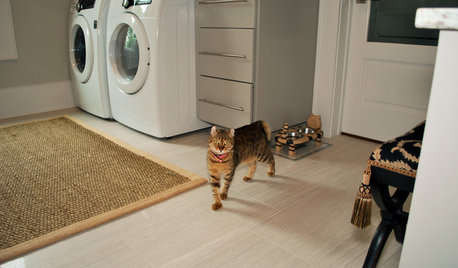Attic Air Handler Dripping Water into Emergency Pan
futbole10
12 years ago
Related Stories

DECORATING GUIDES10 Ways to Hide That Air Conditioner
Feeling boxed in designing around your mini-split air conditioner? Try one of these clever disguises and distractions
Full Story
LIFE6 Ways to Cool Off Without Air Conditioning
These methods can reduce temperatures in the home and save on energy bills
Full Story
MOST POPULAR5 Ways to Hide That Big Air Conditioner in Your Yard
Don’t sweat that boxy A/C unit. Here’s how to place it out of sight and out of mind
Full Story
SAVING WATER11 Ways to Save Water at Home
Whether you live in a drought-stricken area or just want to help preserve a precious resource, here are things you can do to use less water
Full Story
HOUSEKEEPINGProtect Your House From Winter Water Damage
Avoid costly repairs by learning to spot potential problem areas before water damage is done
Full Story
LANDSCAPE DESIGNGet Along With Less Lawn — Ideas to Save Water and Effort
Ditch the mower and lower your water bill while creating a feast for the eyes with diverse plantings and gathering places
Full Story
GREAT HOME PROJECTSHow to Switch to a Tankless Water Heater
New project for a new year: Swap your conventional heater for an energy-saving model — and don’t be fooled by misinformation
Full Story
THE HARDWORKING HOMEA Laundry Makes Room for a Diva Cat
A South Carolina laundry room was designed to be sophisticated and functional, but when a kitten arrived, whimsy emerged
Full Story
MATERIALSBrace for Brass: How This Warm Metal Can Boost Your Bathroom
See what to mix with this trendy alloy, how to keep it from showing water spots and more
Full Story
LIFEHow to Prepare for and Live With a Power Outage
When electricity loss puts food, water and heat in jeopardy, don't be in the dark about how to stay as safe and comfortable as possible
Full StoryMore Discussions







energy_rater_la
futbole10Original Author
Related Professionals
Randolph Solar Energy Systems · Riverside Solar Energy Systems · West Jordan Solar Energy Systems · Weymouth Solar Energy Systems · Algonquin Home Automation & Home Media · Berkley Home Automation & Home Media · Delray Beach Home Automation & Home Media · Fairfield Home Automation & Home Media · Hull Home Automation & Home Media · Kissimmee Home Automation & Home Media · Laurel Home Automation & Home Media · West Palm Beach Home Automation & Home Media · Canton Fireplaces · Lake Arrowhead Fireplaces · Atascocita Fireplacesbrickeyee
energy_rater_la
busboy